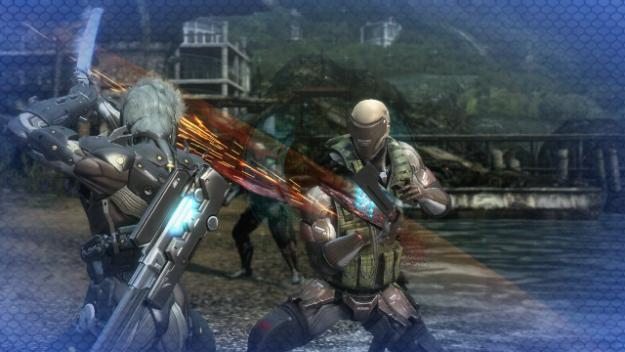
When a game disappears for nearly three years after it was first announced only to re-emerge under the guiding hand of a completely new developer, that’s not a good sign. Shades of Blizzard’s long lost StarCraft: Ghost come to mind. Metal Gear Solid Rising debuted at E3 2009, an eternity ago when Kinect was still called Project Natal and instrument-based music games were still big business. Here at E3 2012, the game is called Metal Gear Rising: Revengeance and while Hideo Kojima’s Kojima Productions is still overseeing the project, it’s now a creation of Bayonetta makers Platinum Games. That’s a lot of time and a significant change of hands, but based on an E3 2012 demo of the game, Metal Gear Rising was worth the wait.
Bayonetta is actually a good reference point for Metal Gear Rising. Though it doesn’t have the same colorful atmosphere, Rising shares that sandy look of Platinum’s other PlayStation 3 and Xbox 360 games. There are plenty of Metal Gear tweaks to the look, from the clean blue and yellow lines of the user interface tracking main character Raiden’s health and combo counter, but it’s easy to see Platinum’s fingerprints on the game. Platinum’s Atsushi Inaba confirmed after my demo that it is running on a modified version of Platinum’s engine.
Unlike Bayonetta though, the camera hangs close to Raiden. The swordplay that makes up the bulk of the demo is as gratuitous and acrobatic as in so many cutscenes in Metal Gear Solid 4: Guns of the Patriots. You are always in control of though, guiding Raiden’s swings. Combat includes regular light and heavy attacks like in so many action games, but pulling the left trigger on your controller activates a mode that moves the camera right behind Raiden’s back and the right analog stick is used for pulling off precise sword movements. A training arena has you practice on dummies, swinging wildly and slicing them into little bits, but soon the dummies hold hostages, showing that precision will be needed later on.
Actually fighting enemies shows how that precision pays off. Activating the blade mode will sometimes make a small targeting reticule appear on a bad guy. Slicing through this will trigger an opportunity to pull out your android opponents’ spines. These recharge Raiden’s battery power, which gradually runs out when in blade mode.
The demo culminates with a boss fight against a helicopter. You bring it down by firing missiles at it from weapons scattered around the stage, but the game encourages you to sprint up pillars in the arena by pulling the right trigger so you can launch yourself in the air to cut on the vehicle. Once the helicopter’s health—y’know because all helicopters have health bars—you can trigger a semi-quick time event that lets Raiden run up the missiles as they’re fired at him and then launch into the air to cut apart the rotors keeping it aloft. It’s flashy, ridiculous, and invigorating.
As solid as the demo is though, Rising is still rough around the edges. As a result of the camera hanging so close to Raiden, the action is sometimes obscured in crucial moments. Control of the sword in blade time also doesn’t feel quite as tight and controlled as it should be at this point, lending itself more to wild swings. Metal Gear Rising Revengeance is far from release though, with only a vague release date of early 2013. There’s time to iron out these kinks. Platinum and Kojima are committed to quality though and their track record is solid. It was one of this E3’s best games.



